OHS 구성요소를 사용하면 FHIR을 더 쉽게 채택할 수 있습니다. 별도로 사용하거나 결합하여 엔드 투 엔드 디지털 의료 플랫폼의 기반을 형성할 수 있습니다.
FHIR 기반 Android 앱
개발자는 Android FHIR SDK를 사용하여 FHIR 네이티브 Android 애플리케이션을 빠르게 빌드할 수 있습니다. SDK는 다양한 사용 사례에 유연성을 제공하도록 설계된 모듈식 라이브러리 집합입니다. 여기에는 다음을 사용하는 경우가 포함됩니다.
- 기존 애플리케이션의 구조화된 데이터 캡처 라이브러리를 사용하여 FHIR을 통한 데이터 수집을 사용 설정
- FHIR 엔진 라이브러리를 사용하여 FHIR에서 오프라인 우선 솔루션을 빌드합니다.
- WHO 스마트 가이드라인 콘텐츠에서 CQL 기반 임상 의사 결정 지원을 지원하는 워크플로 라이브러리의 고급 기능을 제공합니다.
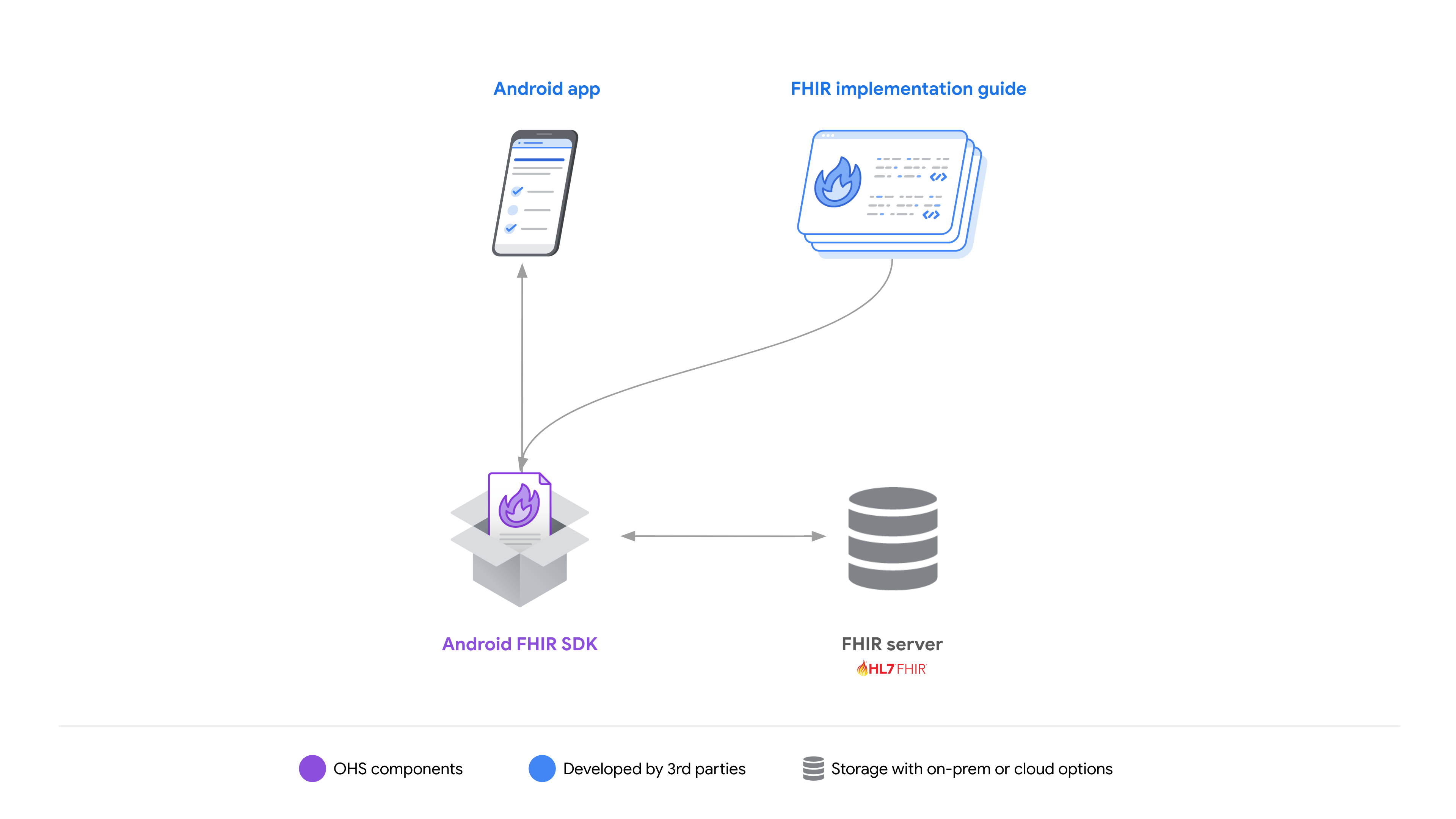
리소스:
- SDC Codelab으로 빠르게 시작하세요.
- 개발자가 OHS로 모바일 솔루션을 빌드하는 방법을 읽어보세요.
SMART-on-FHIR을 활용하여 개인 정보 보호 강화
FHIR 정보 게이트웨이는 모든 애플리케이션 앞에 배포할 수 있는 독립형 역방향 프록시로, 개인 정보 보호를 강화하고 조직 액세스 제어 정책을 더 쉽게 구현할 수 있도록 합니다. 또한 정보 게이트웨이를 Android FHIR SDK 기반 애플리케이션과 함께 사용하면 동기화 작업을 향상할 수 있습니다. 예를 들어 특정 의료 종사자가 오프라인으로 작업할 때 다운로드하고 액세스할 수 있는 환자 데이터를 제한할 수 있습니다.
독립형 프록시인 Info Gateway는 SMART-on-FHIR 애플리케이션과의 통합을 지원합니다.
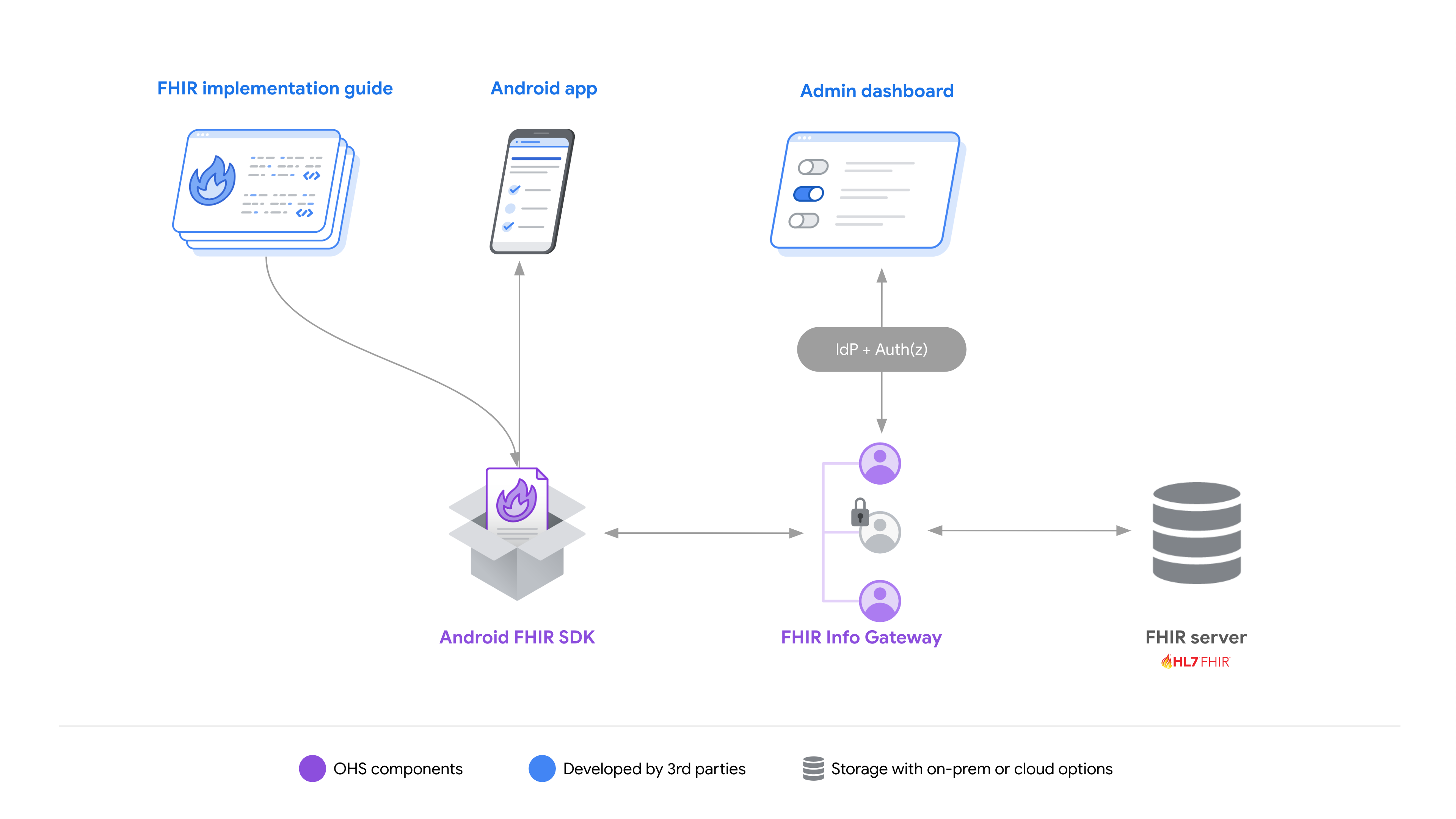
리소스:
- FHIR 앱 예시 저장소를 살펴보고 FHIR 정보 게이트웨이를 다른 OHS 구성요소와 함께 사용하는 방법을 알아보세요.
FHIR 분석 솔루션
FHIR 데이터의 중첩 구조로 인해 쿼리를 작성하여 통계를 생성하는 것이 어려울 수 있습니다. FHIR 데이터 파이프는 FHIR 데이터를 SQL-on-FHIR 형식으로 변환하여 SQL을 통해 FHIR 데이터를 쿼리할 수 있는, 쉽게 배포 가능하고 수평적으로 확장 가능한 파이프라인으로 문제를 단순화합니다.
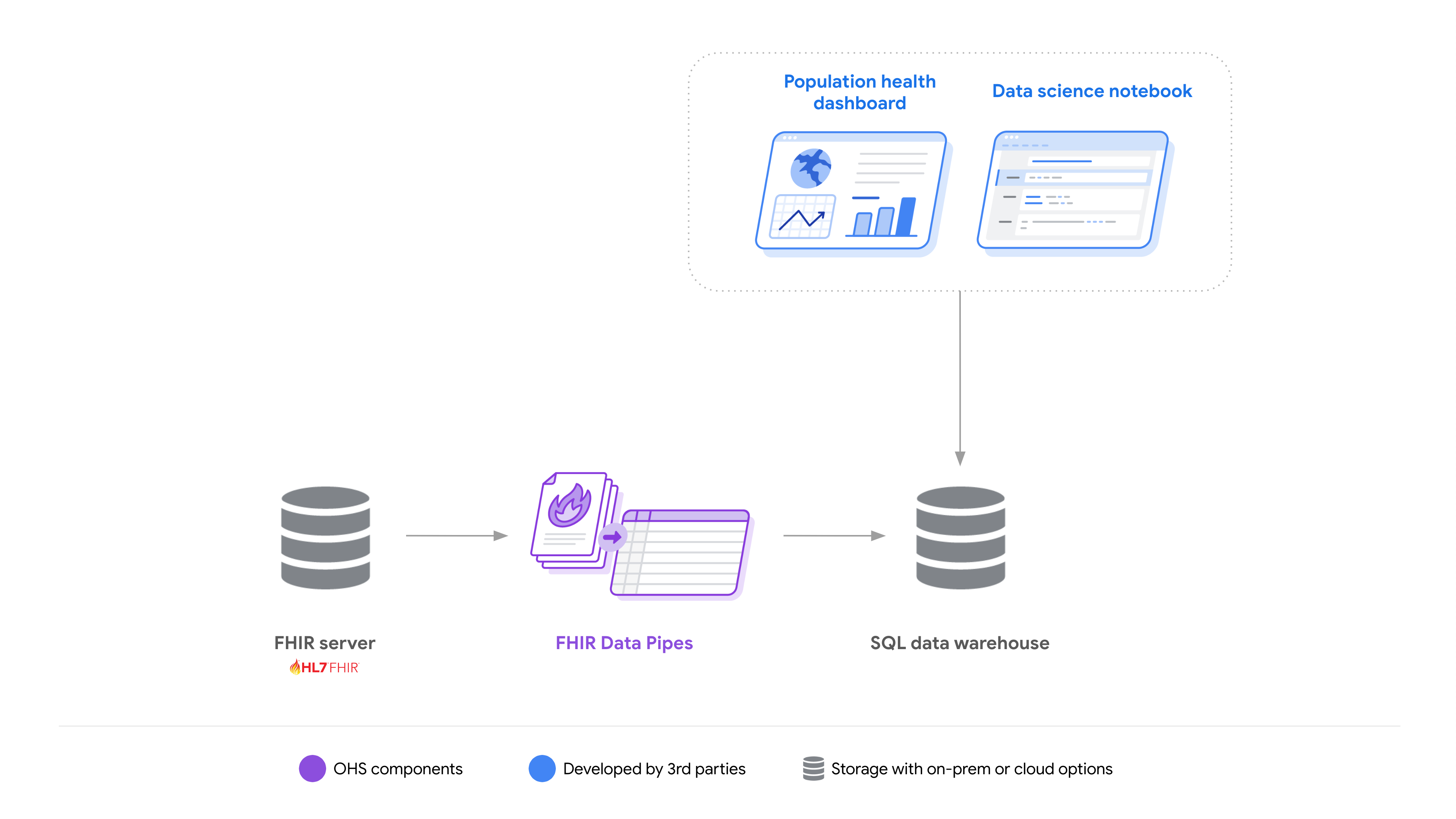
FHIR 데이터 파이프는 FHIR이 분석할 데이터의 소스인 경우에 유용합니다. 일반적인 개발자 시나리오는 다음과 같습니다.
- FHIR 네이티브 모바일 의료 솔루션의 확장 프로그램 - 엔드 투 엔드 디지털 의료 솔루션의 기초 참고
- FHIR을 활용하는 독립형 분석 솔루션의 일부로 하이브리드 아키텍처 예시 참고
리소스:
- 단일 머신 배포 튜토리얼에 따라 빠르게 시작하세요.
- FHIR 앱 예시 저장소에서 FHIR 데이터 파이프를 다른 OHS 구성요소와 함께 사용하는 방법을 알아보세요.
엔드 투 엔드 디지털 의료 솔루션의 토대
모든 OHS 구성요소를 함께 사용하면 개발자가 FHIR 기반 플랫폼 또는 솔루션을 빌드할 수 있습니다. 동기화 및 오프라인 기능과 같은 여러 핵심 기능을 제공하고 FHIR 작업의 기술적 복잡성을 줄여 개발자는 상당한 시간을 절약하고 솔루션의 가치에 더 집중할 수 있습니다.
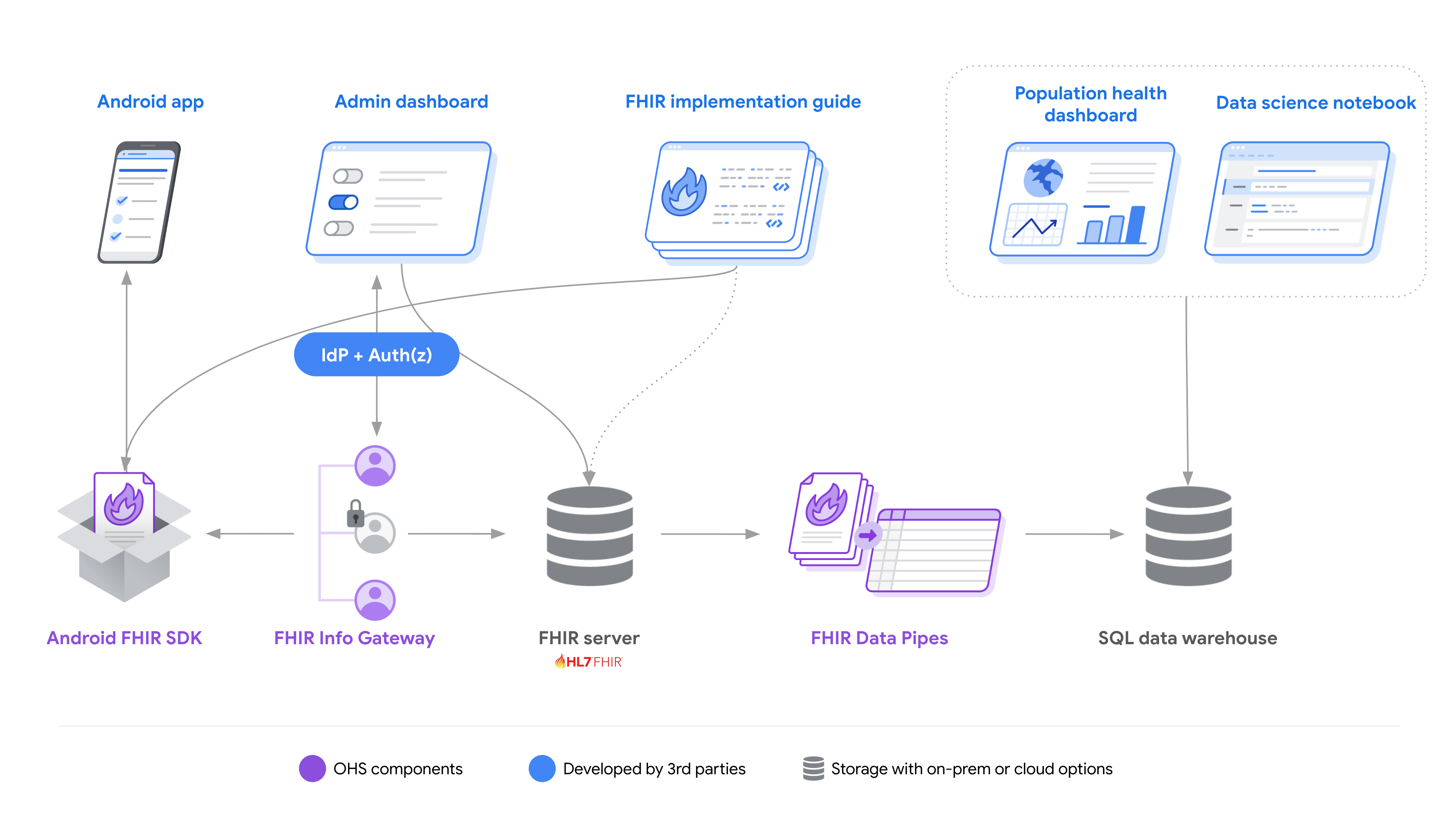
리소스:
- 모든 구성요소를 함께 사용하는 방법을 알아보려면 FHIR 앱 예시 저장소를 살펴보세요.
- Ona가 OHS를 사용하여 OpenSRP FHIRCore를 빌드한 방법 알아보기
하이브리드 아키텍처 예시
OHS 구성요소 모듈성을 통해 개발자는 특정 문제를 해결하는 데 가장 도움이 되는 요소를 고를 수 있습니다.
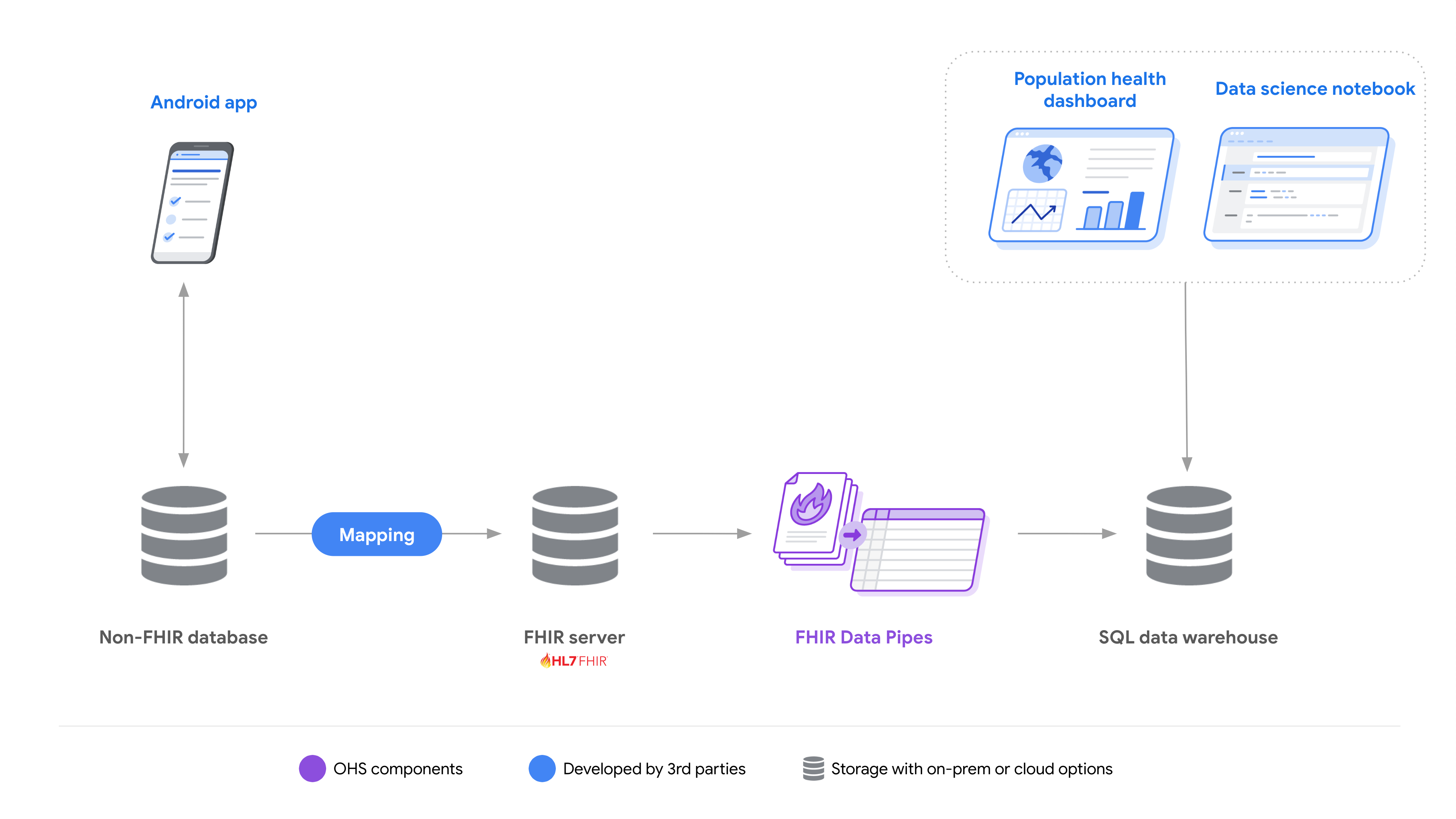
솔루션의 다른 부분은 그대로 유지하면서 기존 시스템의 일부를 FHIR로 전환하는 것이 유용할 수 있는 예가 많습니다. 예를 들면 다음과 같습니다
FHIR 기반 분석에 대한 비 FHIR 데이터 수집: 이 시나리오에서는 FHIR 이외의 방식으로 수집된 데이터가 FHIR로 변환되어 FHIR 데이터에서 유용한 정보를 생성하는 일반적인 접근 방식에 OHS FHIR 데이터 파이프를 사용할 수 있도록 합니다. 데이터를 변환하기 위해 개발자는 기존 공급업체 API 또는 기존 서드 파티 서비스(예: Global Goods 승인 OpenFn)를 사용하거나 관련 오픈소스 프로젝트를 활용할 수 있습니다.
비 FHIR 시스템에 FHIR 네이티브 앱 사용: 이 시나리오에서는 Android FHIR SDK를 사용하여 빌드된 FHIR 네이티브 모바일 앱이 FHIR 서버에 동기화된 데이터를 사용한 오프라인 진료 제공에 사용됩니다. FHIR 서버 개발자는 기존 시스템, 서드 파티 어댑터 또는 커스텀 코드와의 통합을 구현할 수 있습니다.
리소스:
- 모든 구성요소를 함께 사용하는 방법을 알아보려면 FHIR 앱 예시 저장소를 살펴보세요.

